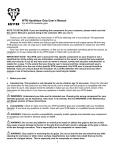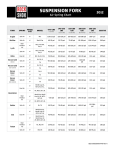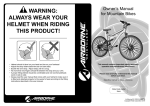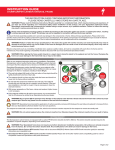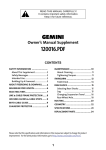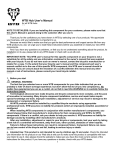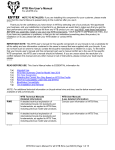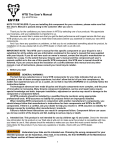Download WTB Saddle User's Manual - wtb
Transcript
WTB Saddle User’s Manual For all WTB saddles V 12 NOTE TO RETAILERS: If you are installing this component for your customer, please make sure that this User’s Manual is passed along to the customer after you use it. GI3-0309 Thank you for the confidence you have shown in WTB by selecting one of our products. We appreciate your business, and your satisfaction is important to us. Because we would like to make sure that you get the best performance and longest service life from any WTB product you use, we urge you to read these instructions before you assemble or install your new WTB components. And if you have any questions or problems, or feel you do not understand something about the product, its installation or its use, please talk to any WTB dealer or check with us at wtb.com. GI1-0508-1 IMPORTANT NOTE: This WTB user’s manual for this specific component on your bicycle is not a substitute for all the safety and use information contained in the owner’s manual that was supplied with your bicycle. If you do not have such an owner’s manual, contact the bicycle's manufacturer or retailer for a copy. To the extent that your bicycle user’s manual and this component part user’s manual conflict as to the use of this specific WTB component, this WTB user’s manual should be followed. If you are unsure about the resolution of a conflict between this manual and any other manual or set of instructions, please consult your local bicycle retailer. GI2-0309 1. Before you start GENERAL WARNING: The fact that you selected one or more WTB components for your bike indicates that you are probably a rider of above average experience; but don’t allow that to lull you into complacency. No matter how experienced you are as a cyclist, do not fail to read this WARNING or to carefully follow the instructions below. Technological advances have made bicycles and bicycle components more complex, and the pace of innovation is increasing. Many bicycle component installation, service and repair tasks require special knowledge and tools. Improper installation, adjustment or service may result in damage to the component or component failure. All WTB products should be installed by a qualified bicycle mechanic using appropriate professional tools. WTB assumes no liability for products which are improperly installed, assembled or configured. When installing WTB components in conjunction with another manufacturer’s components, you should always follow that manufacturer’s instructions for their components and WTB’s for WTB components. If there is a conflict, ask your dealer to help you resolve it. WTB assumes no liability for damage caused by installing other manufacturers’ products. After any installation, adjustment or repair to your bicycle or components, test your work by taking a test ride in a controlled environment, away from cars, other cyclists, obstacles or other hazards. Failure to follow these instructions can result in component failure. Component failure can cause you to lose control of the bicycle and fall, leading to serious injury or death. GW1-0508-1 1 a. Intended Use: This product is not intended for use by children age 12 and under. Check the Intended Use information for his product on our Web site at wtb.com to make sure this product is compatible with how you intend to use it. Also please check the website to make sure you have the most current version of the instructions for this product. If you have any questions or doubts, check with your WTB dealer. IU1-1108-3 WARNING: Understand your bike and its intended use. Choosing the wrong component for your intended purpose can be hazardous. Also read, in its entirety, the first WARNING of the Maintenance and Repair section of these instructions. IU2-0508-1 b. Compatibility: Check to make sure that your WTB saddle’s 7mm or 8mm round saddle rails are compatible with your seat post clamp mechanism. If you have any questions or doubts, check with your WTB dealer, the seat post manufacturer or a qualified bicycle mechanic. SA1-0508-1 WARNING: Failure to confirm compatibility, properly install, operate and maintain any component or accessory can result in serious injury or death. CO2-0508-1 2. Installation & adjustment Undo the seat post saddle clamp sufficiently to allow you to seat the saddle rails into the clamp’s grooves. Tighten the clamping bolt(s) just enough to hold the rails in the grooves, but not enough to prevent fore-and-aft or angle adjustment; then position the saddle as follows: a. Front and back adjustment: The saddle can be adjusted forward or back to help you get the optimal position on the bike. Make sure that the clamp mechanism is clamping on the straight part of the saddle rails and is not touching the curved part of the rails, and that you are using the seat post manufacturer’s recommended torque on the clamping fastener(s). b. Saddle angle adjustment: Most people prefer a horizontal saddle; but some riders like the saddle nose slightly angled up or down. If you have a single bolt saddle clamp on your seat post, it is critical that the clamp bolt is sufficiently loose to allow any serrations on the mechanism to fully disengage before you change the saddle’s angle, and then that the serrations fully re-engage before you tighten the clamp bolt to the seat post manufacturer’s recommended torque. c. Saddle height: If, once installed, your new saddle is at a different height than your old saddle, follow the bicycle or seat post manufacturer’s instructions for adjusting saddle height. Also make sure the saddle is aligned straight ahead (left vs. right) SA2-1108-2 WARNING: When making saddle angle adjustments with a single bolt saddle clamp, always check to make sure that the serrations on the mating surfaces of the clamp are not worn. Worn serrations on the clamp can allow the saddle to move, causing you to lose control and fall. Always tighten fasteners to the correct torque as noted in your seat post instructions. Bolts that are too tight can stretch and deform. Bolts that are too loose can move and fatigue. Either mistake can lead to a sudden failure of the bolt, causing you to lose control and fall. Small changes in saddle position can have a substantial effect on performance and comfort. To find your best saddle position, make only one adjustment at a time. WARNING: After any saddle adjustment, be sure that the saddle adjusting mechanism is properly seated and tightened before riding. A loose saddle clamp or seat post clamp can cause damage to the seat post, or can cause you to lose control and fall. A correctly tightened saddle adjusting mechanism will allow no saddle movement in any direction. Before every ride, check to make sure that the saddle adjusting mechanism is properly tightened. A creaking saddle is a sign that something is not tightened properly or is not fitting properly. 2 BPSA-OM9-3B If, in spite of carefully adjusting the saddle height, tilt and fore-and-aft position, your saddle is still uncomfortable, you may need a different saddle design. WTB saddles, like people, come in many different shapes, sizes and padding materials. Your dealer can help you select a WTB saddle which, when correctly adjusted for your body and riding style, will be comfortable; and you can test-ride the saddle through our WTB Dealer Test Ride Kit Program. SA3-0508-1 WARNING: Some people have claimed that extended riding with a saddle which is incorrectly adjusted or which does not support your pelvic area correctly can cause short-term or long-term injury to nerves and blood vessels, or even impotence. If your saddle causes you pain, numbness or other discomfort, listen to your body and stop riding until you see your dealer about saddle adjustment or a different saddle. Never ride with pain. BPSA-OM9-3B 3. Maintenance and Repair WARNING: Many bicycle component installation, service and repair tasks require special knowledge and tools. Do not begin any installation, adjustments or service on your bicycle until you have learned from your dealer how to properly complete it. Improper installation, configuration, adjustment or service may result in damage to the component or component failure. Component failure can cause you to lose control and fall. BPSA-OM9-5 Like any mechanical device, a bicycle and its components are subject to wear and stress. Different materials and mechanisms wear or fatigue from stress at different rates and have different life cycles. If a component’s life cycle is exceeded, the component can suddenly and catastrophically fail, causing serious injury or death to the rider. Creaks, scratches, cracks, fraying and discoloration are signs of stress-caused fatigue and indicate that a part is at the end of its useful life and needs to be replaced. While the materials and workmanship of your bicycle or of individual components may be covered by a warranty for a specified period of time by the manufacturer, this is no guarantee that the product will last the term of the warranty. Product life is often related to the kind of riding you do and to the treatment to which you submit the bicycle and its components. The warranty is not meant to suggest that the bicycle or a component cannot be broken or will last forever. It only means that the bicycle or component is covered subject to the terms of the warranty. BPSA-om9-5A The “useful life” of this component (the time during which the component is safe to ride) will be reduced if (1) you use it more than the average user; (2) you are heavier than the average rider; (3) the terrain/roads you ride on is rougher than average; (4) you tend to be harder on components than the average rider; (5) you fail to follow its installation instructions or maintenance instructions, including lubrication and adjustment; (6) it must endure more adverse environmental conditions than the average component (i.e. sweat, corrosive mud, salty beach air etc.); (7) you damage/weaken it in a crash, jump or through other abuse; (8) you fail to purchase the appropriate model of product for the type of riding it endures; and/or (9) you race with the component or participate in any other type of extreme, aggressive riding such as Aggro, Hucking, Freeride, North Shore, Downhill, Jumping, Stunt Riding, etc. The more factors you meet and the more often they occur, the more this component’s life will be reduced, however it is impossible to say how much. Racing (road, mountain or triathlons) places extreme stress on bicycles and their components (like it does riders) and significantly shortens their usable or “useful” life (the time during which the component is safe to ride). If you participate in these types of events, the lifetime of the product may be significantly shortened depending upon the level and amount of racing. The “normal wear” of a component may differ greatly between competitive and non-competitive uses, which is why professional level riders often use new bikes and components each season as well as having their bikes serviced by professional mechanics after each ride. Particular care should be placed in the regular examination of your bicycle and it’s components to insure your safety. 3 UL2-0508-1 If you engage in extreme, aggressive stunt or competition riding, you will get hurt, and you voluntarily assume a greatly increased risk of injury or death. Not all bicycles, components or equipment are designed for these types of riding, and those that are may not be suitable for all types of aggressive riding. Check with the bicycle’s or component’s manufacturer about suitability before engaging in extreme riding. When riding fast down hill, you can reach speeds achieved by motorcycles, and therefore face similar hazards and risks. Have your bicycle and equipment carefully inspected by a qualified mechanic and be sure it is in perfect condition. Consult with expert riders, area site personnel and race officials on conditions and equipment advisable at the site where you plan to ride. Wear appropriate safety gear, including an approved full face helmet, full finger gloves, and body armor. Ultimately, it is your responsibility to have proper equipment and to be familiar with course conditions. Although many catalogs, advertisements and articles about bicycling depict riders engaged in extreme riding, this activity is extremely dangerous, increases your risk of injury or death, and increases the severity of any injury. Remember that the action depicted is being performed by professionals with many years of training and experience. Know your limits and always wear a helmet and other appropriate safety gear. Even with state-of-the-art protective safety gear, you could be seriously injured or killed when jumping, stunt riding, riding downhill at speed or in competition. BPSA-OM9-2F a. Maintenance Keep your saddle clean. Leather covered saddles can be cleaned with saddle soap, available in most supermarkets, hardware and drug stores. Vinyl covered saddles can be cleaned with mild soap and water. Fabric covered saddles can be cleaned with a soft-bristled brush. SA5-0508-1 b. Service and Repair Saddles cannot be serviced, and damaged saddles cannot be repaired. They must be replaced. WARNING: Do not ride a saddle that has been involved in an accident or is otherwise damaged (one with bent, pinched, loose or otherwise deformed rails or with a crack in the plastic shell) If any of the foregoing defects are present the rails or shell could fail suddenly, causing you to lose control and fall. SA6-0508-1 4. Warranty WTB products are warranted against defects in materials and workmanship. To read the full current warranty for your WTB product, see the Warranty section of our Web site, wtb.com GI5-0508-1 5. Making a warranty claim To make a warranty claim, see the Warranty section of our Web site, wtb.com GI6-0508-1 6. Contact Information If you have any questions or problems with any WTB product, please go to wtb.com for help. GI7-0508-1 7. Disclaimer The original English language version/meaning of these instructions supercedes all translations. WTB is not responsible for any errors in translation of these or any product instructions. GI8-0508-1 © Copyright WTB March 2009 4





